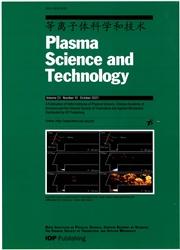燃烧等离子体中反向剪切阿尔费文特征模式的非线性动力学特性
IF 1.6
3区 物理与天体物理
Q3 PHYSICS, FLUIDS & PLASMAS
引用次数: 0
摘要
在稳态运行的托卡马克聚变反应堆中,平衡磁场很可能在堆芯区域具有反向剪切力,因为非感应自举电流曲线通常在轴外达到峰值。反向剪切阿尔弗文特征模(RSAE)作为这种平衡状态下剪切阿尔弗文波的一个独特分支,可以以宽广的波数和频率频谱存在,并受到高能粒子(EP)的共振驱动而不稳定。在简要讨论了燃烧等离子体条件下 RSAE 的线性特性之后,我们通过波-EP 共振和波-波耦合通道回顾了 RSAE 非线性动力学的几个关键主题,并说明了它们在反应堆尺度聚变等离子体中的潜在重要作用。通过简化的混合 MHD 动力学模拟,RSAE 具有典型的宽相空间共振结构,既有循环 EP,也有捕获 EP,这是弱/渐弱磁剪切和相对较低频率的结果。通过波-EP 非线性途径,主导饱和机制主要是由于传输的共振 EP 与局部 RSAE 模式结构径向解耦,由此产生的 EP 传输一般具有对流特征。饱和的 RSAE 还会与其他集体振荡发生各种非线性耦合。我们利用非线性陀螺动理论研究了参数衰减和调制不稳定性这两种典型途径,并将其应用于有限振幅泵 RSAE 自发激发的情况。多个 RSAE 可以自然耦合并诱导频谱能量级联到低频阿尔费尼科模式,该模式可以通过无碰撞朗道阻尼有效地将 EP 能量转移到燃料离子上。此外,零频率带状场结构可通过调制泵 RSAE 包络而自发激发,也可能通过散射到稳定域和连续结构的局部畸变而导致泵 RSAE 饱和。本文章由计算机程序翻译,如有差异,请以英文原文为准。
Nonlinear dynamics of the reversed shear Alfvén eigenmode in burning plasmas
In a tokamak fusion reactor operated at steady state, the equilibrium magnetic field is likely to have reversed shear in the core region, as the noninductive bootstrap current profile generally peaks off-axis. The reversed shear Alfvén eigenmode (RSAE) as a unique branch of the shear Alfvén wave in this equilibrium, can exist with a broad spectrum in wavenumber and frequency, and be resonantly driven unstable by energetic particles (EP). After briefly discussing the RSAE linear properties in burning plasma condition, we review several key topics of the nonlinear dynamics for the RSAE through both wave-EP resonance and wave-wave coupling channels, and illustrate their potentially important role in reactor-scale fusion plasmas. By means of simplified hybrid MHD-kinetic simulations, the RSAEs are shown to have typically broad phase space resonance structure with both circulating and trapped EP, as results of weak/vanishing magnetic shear and relatively low frequency. Through the route of wave-EP nonlinearity, the dominant saturation mechanism is mainly due to the transported resonant EP radially decoupling with the localized RSAE mode structure, and the resultant EP transport generally has a convective feature. The saturated RSAEs also undergo various nonlinear couplings with other collective oscillations. Two typical routes as parametric decay and modulational instability are studied using nonlinear gyrokinetic theory, and applied to the scenario of spontaneous excitation by a finite amplitude pump RSAE. Multiple RSAEs could naturally couple and induce the spectral energy cascade into a low frequency Alfvénic mode, which may effectively transfer the EP energy to fuel ions via collisionless Landau damping. Moreover, zero frequency zonal field structure could be spontaneously excited by modulation of the pump RSAE envelope, and may also lead to saturation of the pump RSAE by both scattering into stable domain and local distortion of the continuum structure.
求助全文
通过发布文献求助,成功后即可免费获取论文全文。
去求助
来源期刊

Plasma Science & Technology
物理-物理:流体与等离子体
CiteScore
3.10
自引率
11.80%
发文量
3773
审稿时长
3.8 months
期刊介绍:
PST assists in advancing plasma science and technology by reporting important, novel, helpful and thought-provoking progress in this strongly multidisciplinary and interdisciplinary field, in a timely manner.
A Publication of the Institute of Plasma Physics, Chinese Academy of Sciences and the Chinese Society of Theoretical and Applied Mechanics.
 求助内容:
求助内容: 应助结果提醒方式:
应助结果提醒方式:


